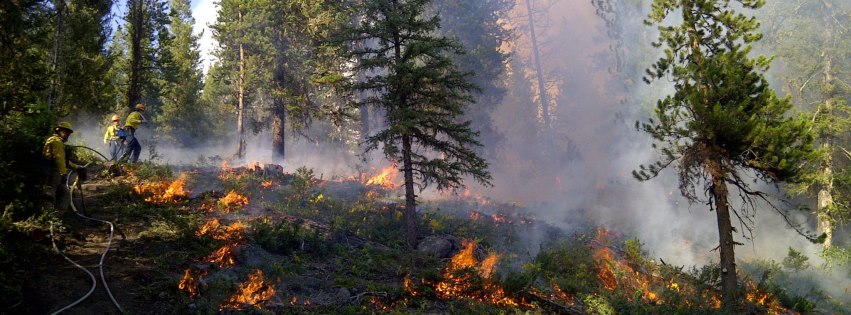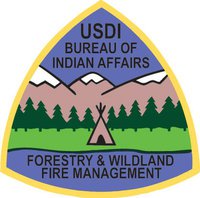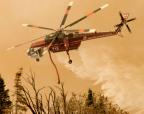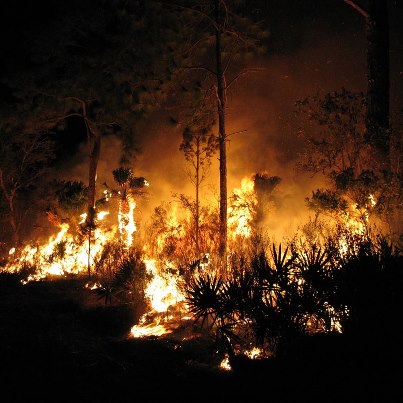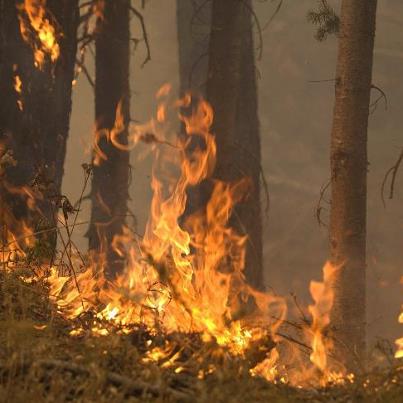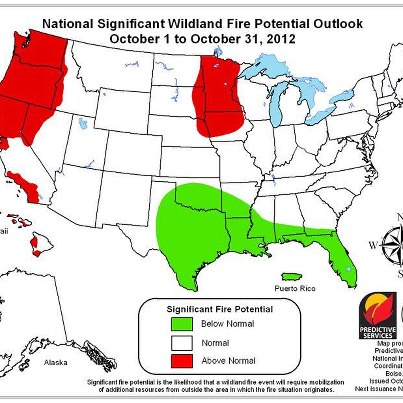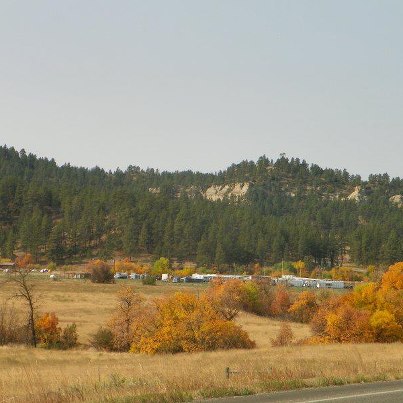- Also On
- RecommendationsSee All
 Christy ForkenbrockWould like to see photos of the Wesley, Idaho Fire.about a month ago
Christy ForkenbrockWould like to see photos of the Wesley, Idaho Fire.about a month ago Patrick ParrishMy suggestion is that we start hiring some of the inmate firefighters when they parole , not so much as to fight fire but to create shaded fuel breaks in strategic places. Not only would that help prevent rapid spread of wild fire it would create jobs for people like me1 · about a month ago
Patrick ParrishMy suggestion is that we start hiring some of the inmate firefighters when they parole , not so much as to fight fire but to create shaded fuel breaks in strategic places. Not only would that help prevent rapid spread of wild fire it would create jobs for people like me1 · about a month ago Karen MarchandJust met some Wildland fire fighters from the Navajo's in Omak,they are working the Coulee Dam fire, just wanted to say thanks..about a month ago
Karen MarchandJust met some Wildland fire fighters from the Navajo's in Omak,they are working the Coulee Dam fire, just wanted to say thanks..about a month ago Matthew Austinhttp://www.qtacfire.com/about 3 months ago
Matthew Austinhttp://www.qtacfire.com/about 3 months ago
- Open to all tribal and government employees! Who doesn't want to learn how to improve communication skills and manage your time more effectively! April 2-3. $220.
- LikesSee All
- National Indian Programs Training CenterGovernment Organization
- U.S. Indian AffairsGovernment Organization
- Intertribal Timber CouncilOrganization
- BLM-National Interagency Fire CenterGovernment Organization
- Wildland Fire Leadership DevelopmentGovernment Organization
- After the very smoky season we've all experienced in Idaho, Montana, Washington and the Dakota's, here is a feel-good pic to help us breath some fresh air. Make it a safe day out there in Indian Country!
- Foresters working in dry mixed conifer forests, like those found in the northwest, may be interested in this fuels guide.
- DFWFM Jobs -
- For BIA, a high percentage of wildfires that burn in Indian Country occur in North Dakota, South Dakota and Nebraska. These areas have precious bison, cattle and other resources tribes wish to protect. Here are some tips that can help ranchers and land managers be proactive when protecting those treasured natural and cultural resources.
- Ridge Top Fire Entrapment Report
At approximately 1822 hours on July 28, 2012, an entrapment occurred on the Ridge Top Fire, Fort Hall Indian Reservation, Blackfoot Idaho. A Bureau of Land Management firefighter sustained first and second d...egree burns while assisting dozer operations in Division X. At the time of the entrapment, the firefighter was utilizing an All-Terrain Vehicle (ATV) to scout line and coordinate dozer activities.See More - There are several PIOs in Indian Country, dedicated to supporting fire communications during the summer. What works for you and can you share that with the rest of us? Please do, BIA-NIFC wants to know!
- Applications for the BIA/ tribal Prescribed Fire Mentoring Program are available online now at: http://www.bia.gov/nifc/training/presmentor/index.htm
The purpose of this program is to offer opportunities to individuals to enhance their wo...rk experience by participating as a trainee or field coordinator/mentor at the Bureau of Indian Affairs (BIA) National Prescribed Fire Mentoring Hub located at the Seminole Agency in Florida or one ofthe Geographic Prescribed Fire Mentoring Hubs.See More
The Seminole program will be able to support two groups of participants this season. Each group of five to seven participants will be organized by Craig Cook, Mentoring Program Coordinator, from the pool of applicants provided by the Regional Fuels Specialists. Length of assignment will be 21 days, including travel.
The Geographic Hubs this year will be hosted by Crow Agency in Rocky Mountain Region and the Mississippi Choctaw in Eastern Region. Crow Agency will offer burning in the months of OctoberlNovember. Actual travel dates for Crow Agency will be coordinated between the hosting unit and the participant once they are selected. Mississippi Choctaw offers burning during the month of March, exact dates will be set dependent on weather. Length of assignment for the Geographic Hubs will be approximately two weeks.
Applications will be accepted from Bureau and Tribal employees currently working in fire management. Application deadline for 2012 Seminole program is November 30, 2012
Application deadline for 2012 Crow Agency (coordinated as received)
Application deadline for 2012 Mississippi Hub is December 30, 2011 - We hit bottom at last! The National Preparedness Level dropped to 1 today.
- The Fall 2012 Forest Service’s Office of Tribal Relations newsletter is out. It's theme this quarter is celebrating youth, education and wisdom. http://www.fs.fed.us/spf/tribalrelations/
- Indian Country has a several all hazard incident management organizations. If interested in participating, don't miss this conference!
- Widlfire seasons are getting longer and more severe and the need to work together to share resources is even greater. This is a handy resource for tribes to look at for looking at ways to engage withthe challenges climate change presents.
- Are you part of fuels treatment planning? Here's a webinar to join if so. "Introduction to the Interagency Fuels Treatment Decision Support System – IFTDSS" on Thursday, October 18th at 1pm MDT. This webinar will introduce the IFTDSS, disc...uss the tools and functionality currently available in the IFTDSS, and will discuss the workflow scenarios that have been developed to address common goals and objectives in fuels treatment planning. Click the link to register. https://www1.gotomeeting.com/register/885322217See More
- DFWFM Jobs -
- The use of suppression strategies that allow fire to play a more natural role in Indian Country helps meet BIA and Tribal goals by creating healthier, productive landscapes that benefit natural and cultural resources. The Alpine Lake Fire, ...burning on the Wind River Reservation is just such a fire. It is winding down now due to cooler temperatures and more precipitation. This slide show was developed by Michelle Buzalsky, a USDA FS Range Technician from Lander, WY to show the fire's progression through the lens of aerial shots. https://docs.google.com/file/d/0BxYDhWzSVYBiX3g1TDh3OHhTNUE/edit?pli=1See More
- Live in Washington and interested in learning how to restore forestland following a wildfire? This Webinar is for you.
- Washington – The Colville Tribe performed an aggressive response last night to try and stop a fast moving wildfire that caused evacuations, a school closure and destroyed homes. An Incident Management Team is on order to manage the 1,000 acre fire that is 0% contained. The fire is under investigation. http://www.krem.com/news/local/Wildfire-forces-evacuations-near-Omak-172388691.html
- We are gearing up for next week - October 7-13. It's National Fire Prevention Week.
http://www.nfpa.org/categoryList.asp?categoryID=2017&URL=Safety+Information%2FFire+Prevention+Week&cookie_test=1 - “We encourage everyone to follow the examples that we honor today, and to prepare themselves, their families, and their neighborhoods for the next emergency.” Be it an ice storm, flood or a wildland fire - do you know what to do in an emergency? The Muckleshoot Tribe did.
- Eastern Area has added a Fuels and Fire Behavior Advisory for Minnesota and Iowa. http://www.predictiveservices.nifc.gov/fuels_fire-danger/fuels_advisories.htm
- The 2012 Interagency Incident Business Management Handbook is now available to order, in hardcopy format, from the Great Basin Cache. Refer to: http://www.nwcg.gov/pms/pubs/
catalog.htm for publication ordering procedures.
For an electronic copy, visit: http://www.nwcg.gov/pms/pubs/large.html#iibmh. - What gives fall its color? For the foresters in the audience - this will take you back to your dendrology class...
"...in the fall, because of changes in the length of daylight and changes in temperature, the leaves stop their food-maki...ng process. The chlorophyll breaks down, the green color disappears, and the yellow to orange colors become visible and give the leaves part of their fall splendor."See More
http://www.esf.edu/pubprog/brochure/leaves/leaves.htm - The northwest isn't out of the woods yet, nor is southern California according to the National Significant Wildland Fire Potential Outlook for October
- It is likely those who stick with wildland fire management and wish to participate on incident management teams will be hearing a lot more about this process in the future. bit.ly/ShcMJ4
- The National Preparedness Level drops to 2, reflecting a downtick in activity.
- Alpine Lake Fire may see snow as early as Wednesday. If so, it could be the season-ending event needed to put the fire out.
http://www.inciweb.org/incident/3137/ - The Navajo Region Supervisory Forester position is on the street. Help share the word and apply!
Duty Position: Fort Defiance, AZ
GS-0460-12/13 (GS-12 : $68,809 - $89,450 Per Annum)
Major Duties:
...As a Supervisory Forester, you will:See More
•Be responsible in planning, managing, and providing program oversight and guidance to the Navajo Region, Division of Forestry activities and to the Navajo Nation Department of Forestry.
•serve as the Branch Chief who provides recommendations to the Regional Director and the Deputy Regional Director of Trust Services in the support of the Division of Forestry, Branch of Forestry, Navajo Nation Departments and Committees; and cooperates with and federal agencies regarding Forestry Management practices on the Navajo Nation Forests.
•Responsible for planning and directing the administration and execution of a program for the management, conservation, protection and utilization of the forest resource in trust ownership on the Navajo Reservation.
•Responsible for the preparation of the budget for all assigned functions and activities based on realistic work load statistics, personnel requirements and equipment needs.
•Collaborates with the Navajo Nation Department of Forestry in preparing project proposals for forestry activities and conducts oversight on funded projects.
•Serves as the Navajo Region, Awarding Official Technical Representative (AOTR) to administer P.L. 93- 638 contracts.
•Provides comprehensive and on-going technical advice and guidance to the Navajo Nation and the Navajo Nation Department of Forestry, Navajo Division of Natural Resources, Navajo Environmental Protection Agency, Navajo tribal leaders in the management and administration of tribally owned forest and related resources.
•Conducts continuing communication and field inspections with permittees, private landowners, contractors, allotted land owners and tribal groups to identify forest management, access negotiation needs including improvements, weed and brush control, seeding, water and wildlife management.
•Responsible for timber sale preparation work includes: selection of sale areas; design of various types of timber cruises; statistical analysis; road planning and cost estimating; silvicultural prescription writing, identification of critical areas requiring special treatment because of potential environmental, ecological, recreation or aesthetic problems; timber value appraisals; preparation of Forest Officer’s Reports.
•Responsible for providing administration of timber sales.
•Coordinates with the Navajo Nation Department of Forestry and representatives of Federal, State and Tribal Natural Resources agencies to analyze the report formulation and provide recommendations for modification of the tentative silviculture prescription to meet identified multiple use objectives (i.e., wildlife protection, watershed protection, recreational use, grazing use, traditional culture forest use value).
•Develops information on short and long-range budgets, prepares annual work plans, manages and monitors specific program finances to insure funds are being used appropriate and reports requirement as the Navajo Region, Forestry Branch Chief.
https://www.usajobs.gov/GetJob/ViewDetails/327716000 - Another weekend has nearly arrived. If you plan to spend your time outside, wear your hunter orange, obey all fire restrictions, and return safely to your families and friends.
- Heads up! We have changing fuel conditions in Western Great Basin and the Northwest geographic areas. Eastern Great Basin also updated their advisory.
- DFWFM Jobs -
- A nice fall picture of the Eagle Creek Fire Incident Command Post, Northern Cheyenne Agency, MT.
The fire is 4,150 acres and 90% contained. The rehabilitation of dozer lines is the priority today.
The Type 2 incident management team wi...ll return command of the fire back to the Northern Cheyenne Agency Saturday morning.See More
Stage 1 Fire Restrictions remain in effect. Information on fire restrictions can be found at http://firerestrictions.us/mt/
Call 406-477-8264 or 406-477-8267 for inquiries on restrictions and closures for the Northern Cheyenne Reservation land. - ActivityOctoberPeople Who Like This30
